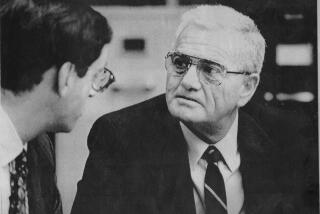The Science of DNA Goes Prime Time : Who would have thought that a murder trial would bring molecular biology to the masses?
- Share via
Forty-two years have passed since two brash young scientists wrought a Copernican revolution in biology. They solved a central mystery of science--how organisms chemically encode the instructions needed to express and perpetuate life. How strange that the O.J. Simpson murder trial would bring the molecular biology of heredity to a prime-time television audience.
In 1953, James D. Watson and Francis Crick announced they had discovered the biophysical structure of the universal genetic material, a chemical called deoxyribonucleic acid, or DNA. It turned out to be a double helix, similar to a spiral staircase, in which two DNA strands are connected by rungs that consist of just four basic molecules--guanine, cytosine, adenine and thymine. Three billion sequences of these molecule pairs, repeating in different combinations in different individuals, are packed into the six feet of DNA coiled in nearly every human cell. They form a kind of digital code that controls the staggering diversity and complexity of animal and plant life.
This discovery, explaining how the DNA strands separate and replicate when cells divide, was a defining moment in the history of science. It was what scientists call “elegant,” by which they mean an economical and simple explanation that brings meaning, harmony and unity to what once seemed unfathomable.
The task of educating the public, not to mention the Simpson jury, on DNA structure and chemistry has fallen to Robin Cotton, director of Cellmark Diagnostics, a Maryland firm retained by the prosecution to analyze blood samples collected by the Los Angeles Police Department. With remarkable lucidity and simple analogies, she has provided a valuable science education on the fine points of DNA.
Ultimately she will get to the forensic point that--except for identical twins--everybody has a unique DNA “fingerprint,” although existing analytical techniques offer great probability but still not 100%-certain identification. The producers who control the TV images emanating from Judge Lance A. Ito’s court had thought this would be the most tedious phase of the trial and considered zapping it. In fact, after weeks of numbing desultory testimony and legal maneuvering, the DNA phase has, so far at least, proved bracing.
Of course, Simpson’s lawyers will attempt to poke holes in the forensic results, questioning the reliability of such scientific techniques as polymerase chain reaction and restriction fragment length polymorphism. But in a trial that has shaken popular confidence in the judicial system, it can at least be said that the public is getting more than a nodding acquaintance with guanine, cytosine, adenine and thymine. Imagine.






